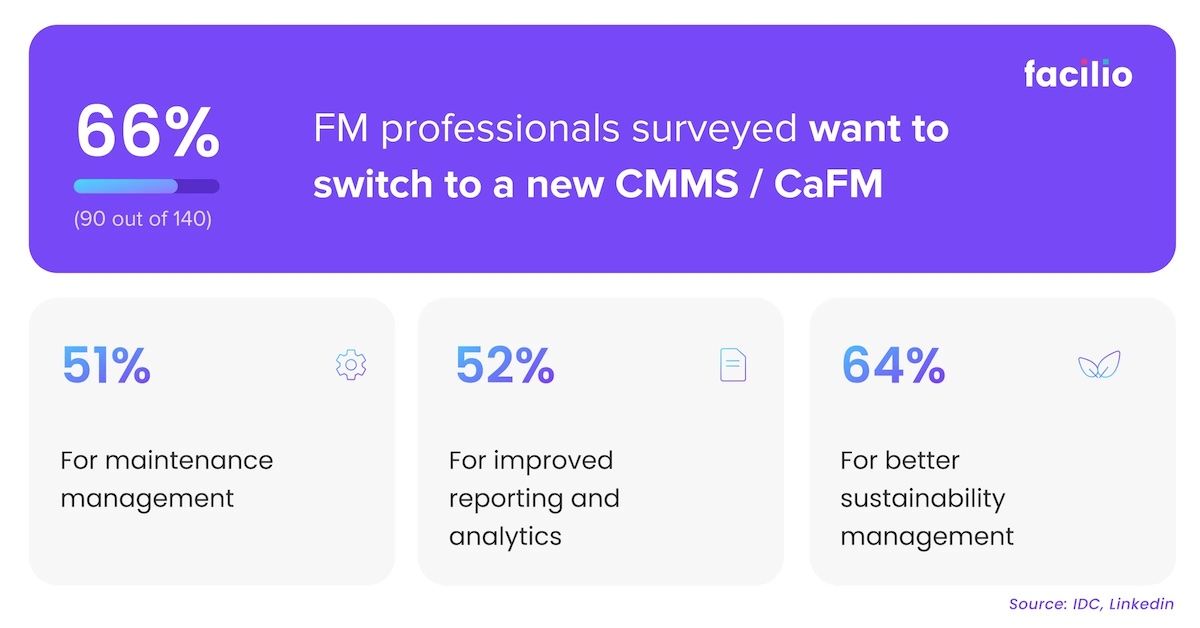CMMS
Happy CMMS users have become a rarity: Here’s why

In Facility Management, the CMMS plays a pivotal role, promising to revolutionize facilities management. However, a recent IDC Report reveals a puzzling paradox.
In the days when legacy CMMSs debuted, the scope of FM was not half as broad as it is today.
With a rapidly evolving FM landscape and a pandemic that forced an acceleration to this shift, facility managers now have to go far beyond just asset and maintenance management to become strategic partners, actively contributing to wellness, and decarbonization, alongside achieving operational excellence at a portfolio scale.
A critical analysis of legacy CMMS (and why users don’t like them)
Legacy CMMS platforms are incredibly complex, leaving seasoned veterans and novices grappling with unfriendly interfaces and impeding operational fluidity. The learning curve can feel steeper than a mountain incline, leaving FMs yearning for simplicity and user-friendliness.
They are also rigid and don’t interoperate with other essential O&M applications, creating functional and system silos at every level. Trapped in these silos is invaluable data.
Naturally, CMMS users are discontent with legacy systems' reporting and analytics capabilities that fail to procure necessary data and, consequently, cannot sieve meaningful insights.
Next, decarbonization's growing importance and regulatory requirements cannot be understated. Legacy CMMS, caught in a time warp, fails to provide the tools and data necessary to drive portfolio-scale sustainability initiatives, impinging on the broader organizational mission.
Unearthing user discontent: Voices from the field
Switching CMMS solutions is a significant, time-consuming, and sometimes expensive change, despite which over 90 of the 140 FM professionals we surveyed recently wanted to switch to a new CMMS. This tells how deeply frustrated they are by the large gaps legacy systems leave.
The CMMS was originally built with a technician-only focus and intended to be a “system of records” for maintenance operations.
As a result, unsurprisingly, most FM work happens outside the CMMS.
FMs have been adopting multiple point solutions to fill the many gaps legacy CMMS leave.
Investa, one of Australia’s largest and most recognized commercial office real estate companies which manages and owns high-performance facilities, resorted to the buy + build model with point solutions too.
Case 1: Point solutions fill gaps left by add to the silos of legacy systems
Talking to Facilio, Paul Vandervlis, the General Manager of Facilities Services, on their tech stack’s inability to manage O&M and concierge services at scale, said:
“Our buildings are designed for the way people work today–and the way we want to work in the future. We think of our office buildings as communities as well as assets. Yet, our property operations were siloed and hindered the stellar customer experience we want to offer.”
Investa’s facilities management teams manage 150+ vendors across three databases for payments, on-site safety, and work orders.

This dizzying system presented significant challenges. The many point solutions they used daily sat in silos, forcing manual workflows and tracking. This complex web of solutions forced Investa to rely on vendors for systems and data around invoices, quotes, and performance metrics.
Too many cooks spoil the broth, as do too many point solutions that don’t interoperate.
This motivated them to look for a better solution–one that could consolidate silos across multiple systems from over ten years of operations.
They needed unified operations and integrated functions, including maintenance management, asset management, incidents, and audits, vendor relationship management, tenant management, and more across portfolios.
This connected ecosystem is a centralized command center for all things O&M that gave Investa complete visibility into portfolio operations.
They needed to unify systems, processes, and people across the portfolio and real-time actionable insights to enable agile, data-led operations–something legacy CMMS couldn’t have done for them.
Case 2: CMMS, where is my data?
Data is everything for another customer of Facilio–AI Tayer, a Middle Eastern Conglomerate that is a complex business with 140+ buildings and 70,000+ assets to manage. The business's complexity and legacy systems' inability to accommodate them directly impacted the bottom line and its reputation.
In addition to all the issues Investa had, the lack of direct, real-time, scalable access to data about their portfolio-wide operations hindered their ability to leverage their critical assets, elevate operational effectiveness, and stay true to their mission “to make passion our currency, relationships our bottom line, and trust our trademark.”
Without data, ideas are just assumptions.
So they decided to switch to a solution that could interoperate with other enterprise apps, automate custom workflows, provide a centralized help desk and tenant portals to facilitate easy communication and provide visual, highly customizable reporting dashboards to give stakeholders complete transparency across portfolio operations.
Beyond streamlining and automating O&M, a unified platform gives them granular visibility into portfolio-wide operations, delivers hassle-free contracted O&M, saves service costs, and enables better service delivery.
To quote the founder of the World Wide Web, Sir Timothy John Berners-Lee,
“Data is a precious thing and will last longer than the systems themselves.”
Done right, data analytics generate insights that bring to life whole new initiatives–not mere process tweaks.
Decarbonization is another such area where without data, organizations are blind, deaf, and very lost, venturing into a rapidly evolving future of FM.
Case 3: Net Zero - the straw that broke the camel’s back
Sustainability is now integral to O&M–irrespective if the existing technology is up to the task.
In a Twitter post, Tom Seyer, an American climate investor, wrote,
“When it comes to the climate crisis – winning slowly is the same as losing. To rebuild the world, we need to innovate, accelerate, and scale bold climate solutions.”
Your CMMS, which sits at the heart of all things O&M, is uniquely positioned to leverage data from your buildings and assets to identify gaps and inefficiencies that can be addressed with simple workflow and process changes and pave the path for data-driven sustainability management.
Committed to the UAE government’s ‘Net Zero by 2050’ vision, the Dubai World Trade Center (DWTC) has been working on consolidating the foundations for a low-carbon economy.
Friends of legacy systems–lack of real-time insights and siloed systems–created hurdles for DWTC, resulting in penalties, high energy consumption, and unplanned downtime.
They needed a centralized, AI and IoT-powered property management solution to optimize energy programs at a portfolio scale. DWTC identified 8% energy wastage three weeks after implementing the new platform, representing potential savings of $1,36,126.45 USD annually!
Who knew the path to net zero was through the CMMS!
FMs knew. They knew. And they made themselves very clear.
64% of them from the IDC report mentioned earlier were frustrated enough to make the switch, knowing their CMMS needed to do a much better job at sustainability management.
The call for change: Reimagining the ideal CMMS
Envisioning a renaissance, a modern cloud-based CMMS is rooted in simplicity, data-centricity, interoperability, and seamless scalability. Powered by AI and IoT, the reimagined CMMS centralizes portfolio-wide data from systems, processes, and people, transforming them into actionable insights.
An all-encompassing CMMS can potentially transform into a "system of action" enabled by connected operations–A Connected CMMS. This path marks simplified operations, data-driven insights, and a strong commitment to sustainable practices, guiding Facility Management toward an era where happy CMMS users become a norm.



